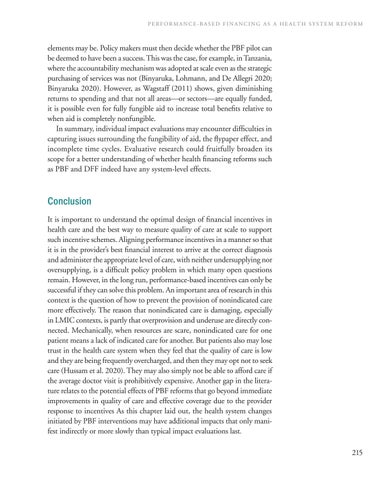P erformance - B ased F inancing as a H ealth S ystem R eform
elements may be. Policy makers must then decide whether the PBF pilot can be deemed to have been a success. This was the case, for example, in Tanzania, where the accountability mechanism was adopted at scale even as the strategic purchasing of services was not (Binyaruka, Lohmann, and De Allegri 2020; Binyaruka 2020). However, as Wagstaff (2011) shows, given diminishing returns to spending and that not all areas—or sectors—are equally funded, it is possible even for fully fungible aid to increase total benefits relative to when aid is completely nonfungible. In summary, individual impact evaluations may encounter difficulties in capturing issues surrounding the fungibility of aid, the flypaper effect, and incomplete time cycles. Evaluative research could fruitfully broaden its scope for a better understanding of whether health financing reforms such as PBF and DFF indeed have any system-level effects.
Conclusion It is important to understand the optimal design of financial incentives in health care and the best way to measure quality of care at scale to support such incentive schemes. Aligning performance incentives in a manner so that it is in the provider’s best financial interest to arrive at the correct diagnosis and administer the appropriate level of care, with neither undersupplying nor oversupplying, is a difficult policy problem in which many open questions remain. However, in the long run, performance-based incentives can only be successful if they can solve this problem. An important area of research in this context is the question of how to prevent the provision of nonindicated care more effectively. The reason that nonindicated care is damaging, especially in LMIC contexts, is partly that overprovision and underuse are directly connected. Mechanically, when resources are scare, nonindicated care for one patient means a lack of indicated care for another. But patients also may lose trust in the health care system when they feel that the quality of care is low and they are being frequently overcharged, and then they may opt not to seek care (Hussam et al. 2020). They may also simply not be able to afford care if the average doctor visit is prohibitively expensive. Another gap in the literature relates to the potential effects of PBF reforms that go beyond immediate improvements in quality of care and effective coverage due to the provider response to incentives As this chapter laid out, the health system changes initiated by PBF interventions may have additional impacts that only manifest indirectly or more slowly than typical impact evaluations last. 215

